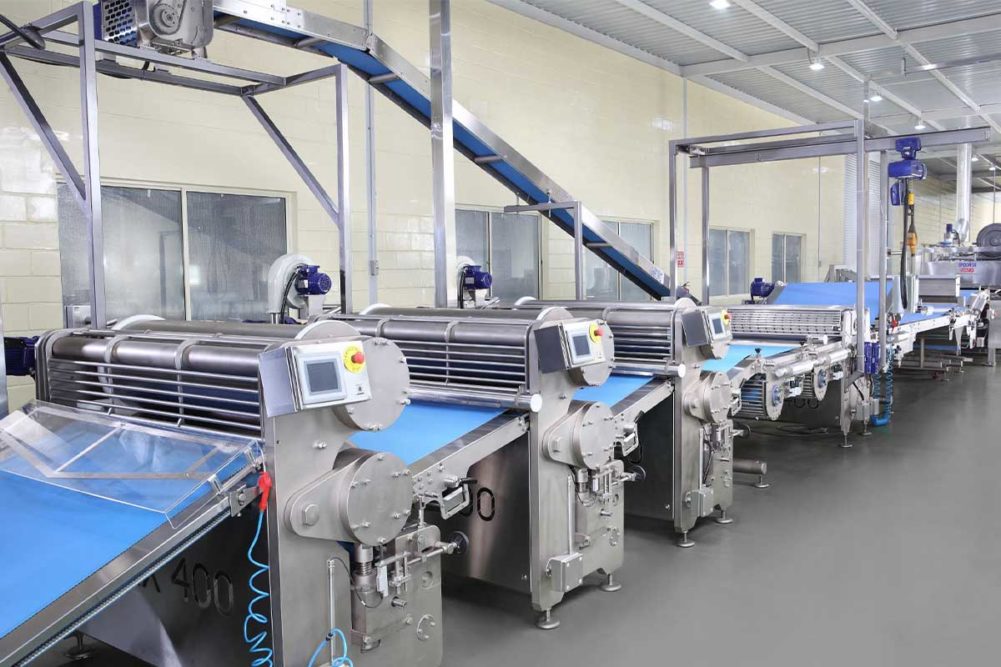Bakers may also experience several challenges in mixing highly viscous doughs for cookies and bars.
“At its core, it’s a delicate balance between effective ingredient incorporation to create a perfectly homogenous dough while avoiding inclusion degradation that can result from the mixing process,” said Katie Winkle, sales director, Baker Perkins.
She pointed out that Baker Perkins’ high-speed mixers offer a shaftless blade design that allows ingredients to move more freely about the mixing bowl for rapid, even dispersion and blending with minimal damage to inclusions.
Since 1945, Spooner Vicars has relied on its double-helical bladed, sigma-style mixer that was recently updated with direct drive, open frame and other updated hygienic designs, noted Dan Christie, sales manager, North America, Spooner Vicars Bakery Systems, a Middleby Bakery company.
The sprag mixer features what looks to be a shark fin sticking up between the two helical blades, which provides additional sheer force that can reduce mix time by up to 15% before the over-tilt system dumps the batter into a trough or dough feeder.
Jim Warren, vice president, Exact Mixing, RBS, suggested that continuous mixers can handle highly viscous cookie doughs because there is less dough in the system and the cross-sectional area of the mixer is smaller, which reduces forces on the shaft and enhances process efficiency.
“Bars are different than cookies when it comes to continuous mixing,” Mr. Warren said. “While many bars are well suited for continuous mixing, others can be a challenge. This is especially true if binders are used which could cause the mixture to build up on the shaft. This could plug the mixer or cause damage to inclusions.”
One benefit, he added, is that continuous mixers do not require unloading as a separate step. The shafts push the dough out of the mixer in a rope or small chunks, which fall directly into a hopper or onto a belt.
Kevin Knott, technical sales manager, Bühler Group, stressed that bakeries need to collaborate with equipment vendors to ensure that mixers are correctly sized for cookies and doughs to avoid unnecessary downtime.
“If the type of dough viscosity is stated correctly, then manufacturers can make sure they mixed it correctly sized with the relevant factor of safety applied,” he said. “The manufacturer must do the relevant calculations and ensure the motor has adequate load ratings.”
Gooey, chunky or syrupy doughs are tough to pump and portion accurately, but producers have many options.
John McIsaac, vice president, strategic business development, Reiser, noted that the Vemag depositor with its positive displacement double-screw pump provides high levels of portioning accuracy and transports the product gently, without crushing or damaging any inclusions.
Ken Hagedorn, vice president bakery sector, Handtmann, said the company’s vane cell technology comes with a short travel path from the pump to the port where the dough comes out. This process allows the depositor to handle inclusions of all types and sizes.
“Because of that short path, the vane pump causes less damage with nuts or some varieties of berries,” he said. “You’re putting less friction on the dough and less chance for those nuts or fruit to break up or bleed into the dough.”
For baked or cold-formed bars, Ms. Winkle said, bakeries can rely on an extruder and die arrangement or select a sheeted slab process that is then slit and cut.
“But with the forming and downstream processing for each being so different, most often these end up being dedicated lines for one process or the other,” she said.
Specifically, baked bars travel through an oven, while cold-formed products may receive chocolate or other coatings and toppings before traveling through a cooler or freezing tunnel prior to portioning and packaging.
On Spooner Vicars lines, Mr. Christie said, freshly made cookie or bar dough can travel through dough feed rollers to make a sheet or optional kibbler before it heads up an incline to either a wirecut machine or rotary moulder.
Using servo gearmotors on the wirecut machine allows for quick adjustments and better accuracy and less maintenance. Separate feed roll drives provide better control and versatility to create a wider variety of products on a single line. Wirecut operations feature an adjustable feed roll cap on the wirecut for bars or cookies with various sized inclusions.
“Typically for wirecut cookies, you need an 8-mm feed roll gap to push the dough through for ‘best’ product weight control,” he said. “However, if you’re using 10-, 12- or 20-mm inclusions, like chocolate chunks, that would smear on the roll. We can open our rolls up and allow those inclusions to pass through without breaking apart or smearing the inclusions. That works well with gourmet-style cookies or bars that have a lot of inclusions in them.”
To produce bars with an inner filling, Mr. Christie added, manufacturers typically need two hoppers — one for the inner filling and the other for the outside portion.
The filling hopper provides product to the inner die nozzle within the die system. This is done by either using the feed rollers or a separate pump system. As the filling emerges out of the die, the outer part of the bar is created conventionally through feed rolls.
When it comes to snacking, new product innovation is blurring the lines between cookies and bars.
Advances in new technology, however, now allow manufacturers to offer consumers a wider variety of options, whether they’re healthy, indulgent or a little bit of both.
This article is an excerpt from the April 2022 issue of Baking & Snack. To read the entire feature on Cookie & Bar Processing, click here.





